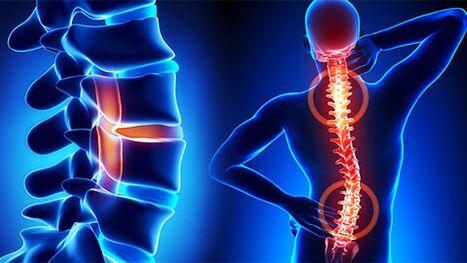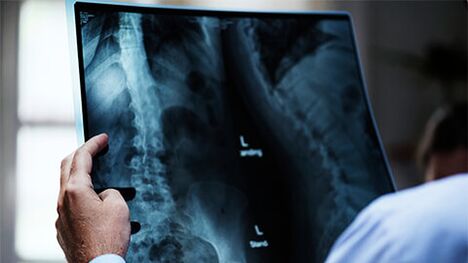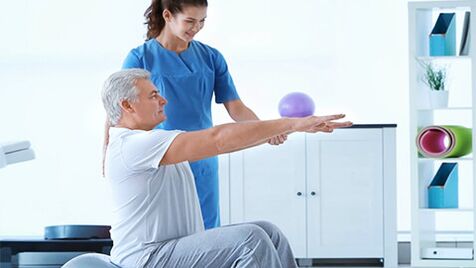
Back pain and numbness are symptoms that affect many people. The episodic occurrence of these unpleasant sensations is possible for several reasons - prolonged inactivity, sitting for a long time or sleeping in the wrong position. The constant presence of such symptoms indicates the development of degenerative-dystrophic lesions of the spinal tissues - osteochondrosis.
Osteochondrosis: what is it?
Osteochondrosis is an extremely common disease, accounting for more than half of the cases of chronic low back pain. As a result of a combination of factors (lack of nutrients in the diet, lack of physical activity, impaired metabolic processes in the body), destructive changes begin to occur in the tissue structure of the vertebrae and intervertebral discs, as well as the bones and ligaments associated with them. This is reflected in a change in shape and a decrease in elasticity.
The vertebrae are compressed and the spine loses stability in the affected areas. The nerve endings in the spinal cord are clamped, and as a result the muscles in the back are constantly in hypertonia. Due to the displacement of the vertebrae, the risk of developing protrusions or intervertebral hernias increases, as well as spondylosis (appearance of bone processes - osteophytes).
Types of osteochondrosis and stages of their development
When making a diagnosis, the location of the degenerative process is taken into account. Osteochondrosis is of four types:
- low back;
- chest;
- cervical;
- generalized (when more than one department is affected).
More often than others, osteochondrosis of the lumbar spine is diagnosed, as it is responsible for the load on the upper half of the body.
In the initial stage, osteochondrosis is hidden under the guise of local symptoms, which is why the patient does not receive timely treatment and the disease continues to progress. The stages of sequential development of the disease are characterized by the following characteristics:
- Displacement of intervertebral discs and instability of vertebrae.
- Reduction of the intervertebral space due to the destruction of the fibrous ring of the discs (compression of the vertebrae).
- Deformation of the line of the spine and the appearance of protrusions or intervertebral hernias due to the rupture of the fibrous ring and protrusion of the nuclei of the disc due to the inadequate load on them.
- The presence of bone growth (spondylosis), due to which the spine loses its flexibility. The patient's movements are extremely difficult and cause severe pain and discomfort.
As with any disease, the sooner osteochondrosis is diagnosed, the greater the chances of a cure. At the same time, after stabilizing the patient's condition, lifelong prevention is necessary to eliminate the risk of relapse: exercise and a special diet. And since most modern people are at risk of developing this pathology, it is best to start a healthy morning exercise habit right now.
The reasons for the development of osteochondrosis
Osteochondrosis is a disease most frequently diagnosed in the elderly due to natural causes of aging of the body and slowing down of metabolic processes. However, in the absence of physical activity and leading a predominantly "sedentary" lifestyle, this disease can develop in younger people. In this case, the weakening of the back muscles can lead to the development of a degenerative process, which interrupts the blood flow and nutrition of the tissues of the vertebrae and the intervertebral discs.
Despite the prevalenceosteochondrosis, causesyouremergencynot fully understood. A combination of factors always leads to the development of a disease, which also includes:
- malformations of the nervous and musculoskeletal systems, hereditary factors; defective physical development;
- violation of the body's metabolic processes, inadequate absorption of nutrients, disturbance of the functioning of the endocrine and digestive systems;
- deficiency of vitamins and minerals in the diet, unbalanced diet, frequent dehydration;
- long-term use of certain medications;
- excess weight and increased spine stress, heavy physical work with inadequate load distribution;
- sedentary lifestyle, prolonged stay in uncomfortable static positions, for example, when working in an office;
- spinal injury; transferred infectious diseases, stress.
It is possible to speak confidently about the disease in the event that, due to the difficulty of access of nutrients to the tissues of the intervertebral discs and vertebrae, degenerative processes begin to develop in them. In this case, regeneration becomes totally impossible and, against the background of the factors that accompany it, there is a gradual destruction of the vertebrae and discs. As a result of the body's natural self-regulating processes, osteophytes can appear in the vertebrae, a kind of spines of bone tissue, which appear to cement the intervertebral space. In this case, the flexibility of the spine is lost and the movements bring pain and discomfort.
Symptoms of the disease
If there is a general similarity, different speciesosteochondrosishave differentsymptoms and signs. . . This is due to the fact that, depending on the location, as a result of the clamping of the vessels, the painful sensations affect the organs and parts of the body located nearby.
For osteochondrosis of the lower back, low back pain is characteristic with sudden movements or prolonged stay in a static position. Due to the clamping of nerve endings, the pain may appear in one or both legs, the nature of the pain varies from pain to sting. When you take a comfortable position, the pain disappears.
The second most common type of osteochondrosis, cervical, is characterized by the following symptoms: the presence of an uncomfortable and pressing headache and dizziness. Unpleasant sensations intensify with the movement of the head, while the use of painkillers does not relieve the pain syndrome. The pain can be given in the chest region, the sensations are similar to angina pectoris, but more prolonged. In addition, there are sharp painful sensations in the hands and fingers, their numbness. Perhaps a sensation of numbness in the tongue, difficulty in performing the speech activity.
Thoracic osteochondrosis is relatively rare. The main reason for its development is the curvature of the spine, with less frequency of injuries. This type of disease is the most difficult to diagnose because the clinical signs are similar to those of other diseases. In addition to the painful sensations in the back, which intensify with movement and flexion, with osteochondrosis of the thoracic spine, pain may occur in the heart, liver and gastrointestinal tract. There is a sensation of numbness in the muscles of the sternum and the functions of Organs genitals are weakened.
Common osteochondrosis combines signs of several types of osteochondrosis.
How is the diagnosis made?

When diagnosing osteochondrosis, the patient's external examination is not sufficient. In addition to collecting data, a neurologist or vertebrologist prescribes the following types of tests to clarify the nature and determine the degree of damage to the spine:
- X-ray;
- Magnetic resonance imaging;
- Computed tomography.
The final diagnosis is made based on the results of the images, after which the appropriate treatment regimen is selected.
How to treat osteochondrosis in the back
Since the occurrenceosteochondrosisa combination of several factors affectstreatmentalways includes a wide range of measurements. After removing the acute condition with the aid of analgesics (if necessary) and indicating a balanced diet, the following recovery methods are used:
- Exercise therapy is physical therapy, a set of exercises that aims to develop damaged areas of the spine and normalize muscle tone. At the same time, physical activity is limited, with the aim of strengthening the muscles of the back and restoring the flexibility of the joints and ligaments. Exercise therapy is considered to be the most effective method for dealing with osteochondrosis, but it should be carried out under the supervision of a specialist. There are several areas of exercise therapy, including kinesiotherapy, health care, classes in special simulators. Exercise therapy has practically no limitations, as in most cases each patient receives an individual set of exercises. You cannot engage in exercise therapy in the acute phase of the illness or with serious spinal injuries.
- Physiotherapy, which has a complex of procedures that aim to reduce pain and stimulate natural regenerative processes in the tissues of the vertebrae and discs. They use the influence of a laser, ultrasound, magnetic vibrations. As an additional method of muscle relaxation and general strengthening of the body, as well as the restoration of the nervous system, baths of conifers or pearls can be prescribed.
- Massage is used to relieve pain and restore blood circulation to the muscles. Massage is not prescribed in the acute phase of the disease.
- Traction or spinal traction. In this procedure, the vertebrae return to their natural position, so that the load on the spine is uniform.
- Reflexotherapy, when used by a specialist, acts on reflex zones and pain points, thus reducing pain. It is used in combination with massage.
- Preventive measures that give a tangible therapeutic effect include the use of special orthopedic devices: mattresses, cushions, orthopedic shoes or insoles, special corsets that support the injured parts of the spine in the correct position.
- Reception of chondroprotectors, which become an additional source of nutrition for damaged tissues. You should also introduce the use of gelatin-based dishes in the diet: jelly, meat with jelly, formaldehyde.
- According to the doctor's prescription, after passing the appropriate tests, foreign experts recommend taking vitamin D3, omega fatty acids and B vitamins.
What will happen if you don't treat osteochondrosis
With premature or incorrect treatment, osteochondrosis can cause the development of the following pathologies:
- Vegetovascular dystonia.
- The brain's hunger for oxygen.
- Intervertebral hernia, which can lead to impaired motor function of the arms or legs.
Prevention methods
The prevention of osteochondrosis should aim to exclude factors that increase the risk of its development. This applies mainly to people who have:
- genetic predisposition to spinal diseases;
- chronic diseases of the gastrointestinal tract, in which the absorption of nutrients is impaired;
- diseases associated with metabolic disorders;
- serious infectious diseases, rickets transferred in childhood;
- spinal injury;
- overweight.
Prevention is very important for people with a sedentary lifestyle, with greater stress on the spine and women who plan to have children.

The main and easiest way to prevent osteochondrosis is moderate and regular physical activity: gymnastics or swimming. It is imperative to monitor your posture, not to sit in unnatural positions for a long time. In sedentary work, it is necessary to take breaks, during which to organize physical exercises - to massage the rigid muscles, restoring blood circulation in them.
As a rule, the usual daily movements, which are performed incorrectly, without taking into account the load they support on the spine, become a concomitant factor in the development of osteochondrosis. For example, you should avoid lifting weights, get rid of the habit of constantly carrying a heavy bag on the same shoulder. You cannot lift heavy objects from the floor from the standing position, first you need to sit down. When doing household chores - cooking, cleaning, washing, stay in the correct position - standing, not bending over.
Another secret is to wear comfortable shoes, ideally orthopedic or with orthopedic insole. It is better to refuse high heels altogether, or at least not wear them all the time.



















